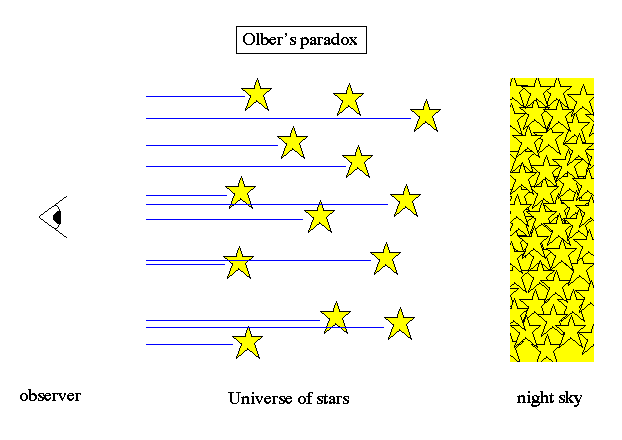
| Readings: |
Olber's Paradox Shape of the Universe |
Olber's Paradox:
The oldest cosmological paradox concerns the fact that the night sky should not appear dark in a very large (or infinite), ageless Universe. It should glow with the brightness of a stellar surface.

There are many possible explanations which have been considered. Here are a few:
The premise of the second explanation may technically be correct. But the number of stars, finite as it might be, is still large enough to light up the entire sky, i.e., the total amount of luminous matter in the Universe is too large to allow this escape. The number of stars is close enough to infinite for the purpose of lighting up the sky. The third explanation might be partially correct. We just don't know. If the stars are distributed fractally, then there could be large patches of empty space, and the sky could appear dark except in small areas.
But the final two possibilities are surely each correct and partly responsible. There are numerical arguments that suggest that the effect of the finite age of the Universe is the larger effect. We live inside a spherical shell of "Observable Universe" which has radius equal to the lifetime of the Universe. Objects more than about 15 billion years old are too far away for their light ever to reach us.
The resolution of Olber's paradox is found in the combined observation that 1) the speed of light is finite (although a very high velocity) and 2) the Universe has a finite age, i.e. we only see the light from parts of the Universe less than 15 billion light years away.
Copernican Principle:
The Copernican Principle is a basic statement in physics that there should be no ``special'' observers. For example, the Aristotelian model of the solar system in the Middle Ages placed the Earth at the center of the solar system, a unique place since it ``appears'' that everything revolved around the Earth. Nicolaus Copernicus demonstrated that this view was incorrect and that the Sun was at the center of the solar system with the Earth in orbit around the Sun.
The implications of Copernicus' work can not be exaggerated. His views challenged the literal interpretation of Scripture, the philosophical and metaphysical foundations of moral theory, and even common sense itself. The result was a massive opposition to his reported ideas. It was the slow, sure acceptance of the heliocentric theory by natural philosophers that ultimately quieted the general clamor, however the name of Copernicus is still a battle cry against the establishment in religion, philosophy and science. In later years with Freud, man lost his Godlike mind; with Darwin his exalted place among the creatures of the Earth; with Copernicus man had lost his privileged position in the Universe.
The lesson learned by future scientists is that if a theory requires a special origin or viewpoint, then it is not plausible. Almost all cosmological and scientific theories are scrutinized by the Copernican principle. Often interpreted that is an idea requires some special condition, then it is incomplete.
Cosmic Edge:
One of the first cosmic riddles is `Is there an edge to the Universe?' This question illuminates one of the common problems in dealing with cosmological issues. By definition, all discussion of the characteristics of the Universe must face the fact that the Universe has to contain the properties of everything. Thus, the term `edge' of the Universe assumes that there exists something that is not contained in the Universe. Invoking an outside property the the Universe (an edge or outside to the Universe) is logically inconsistent since, by definition, the Universe must contain everything.
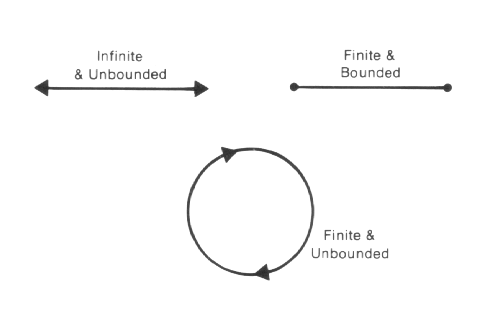
A corollary to this point is that the Universe must be boundless. This does not necessary mean that the Universe is infinite, although this is the simplest solution. Notice also that space is not a receptacle for the Universe, space is physical and is contained with the Universe. Lastly, if the Universe contains everything, the it must contain its own origin mechanism, a bootstrap program.

Through history, these are the various groups/individuals who have proposed a finite or infinite Universe (either in space or time).
| Infinite | Finite | |
| Ancient Greece | Atomists | Plato |
| Milesians | Aristotle | |
| Stoics | ||
| Lucretius | Ptolemy | |
| Medieval Europe | Middle Ages | |
| Dante | ||
| Nicolus of Cusa | ||
| Copernicus | ||
| Kepler | ||
| Classical Cosmology | Digges | |
| Bruno | ||
| Descartes | ||
| Newton | ||
| Kant | ||
| Riemann | ||
| Einstein | ||
| Friedmann | ||
| Lemaitre | ||
| Relativistic Cosmology | Einstein/deSitter | |
| Inflation | ||
| Closed Geometry | ||
Geometry of the Universe:
Can the Universe be finite in size? If so, what is ``outside'' the Universe? The answer to both these questions involves a discussion of the intrinsic geometry of the Universe.
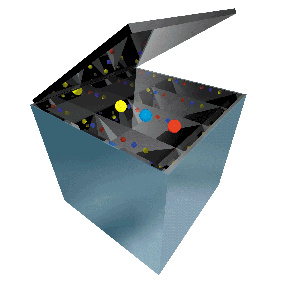
Like a hall of mirrors, the apparently endless universe might be deluding us. The cosmos could, in fact, be small. The illusion of infinity would come about as light wrapped all the way around space, perhaps more than once--creating multiple images of each galaxy. A mirror box evokes a finite cosmos that looks endless. The box contains only three balls, yet the mirrors that line its walls produce an infinite number of images. Of course, in the real universe there is no boundary from which light can reflect. Instead a multiplicity of images could arise as light rays wrap around the universe over and over again. From the pattern of repeated images, one could deduce the universe's true size and shape.

Topology shows that a flat piece of spacetime can be folded into a torus when the edges touch. In a similar manner, a flat strip of paper can be twisted to form a Moebius Strip.
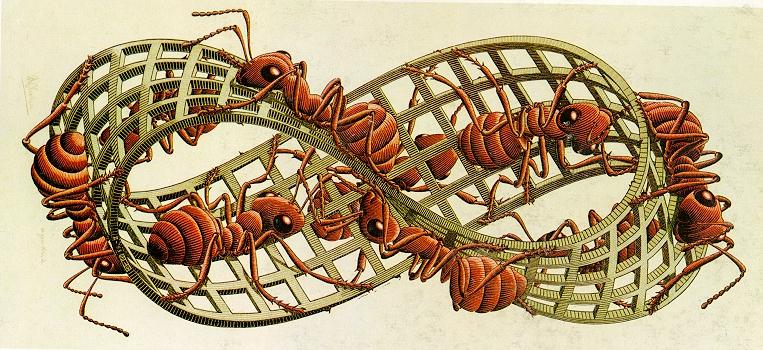
The 3D version of a moebius strip is a Klein Bottle, where spacetime is distorted so there is no inside or outside, only one surface.
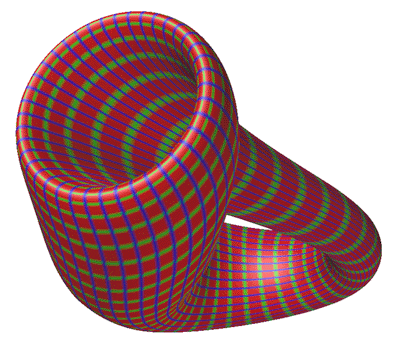
The usual assumption is that the universe is, like a plane, "simply connected," which means there is only one direct path for light to travel from a source to an observer. A simply connected Euclidean or hyperbolic universe would indeed be infinite. But the universe might instead be "multiply connected," like a torus, in which case there are many different such paths. An observer would see multiple images of each galaxy and could easily misinterpret them as distinct galaxies in an endless space, much as a visitor to a mirrored room has the illusion of seeing a huge crowd.
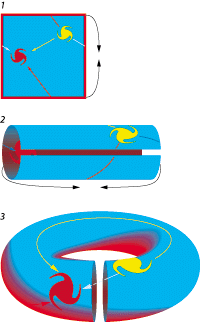
One possible finite geometry is donutspace or more properly known as the Euclidean 2-torus, is a flat square whose opposite sides are connected. Anything crossing one edge reenters from the opposite edge (like a video game see 1 above). Although this surface cannot exist within our three-dimensional space, a distorted version can be built by taping together top and bottom (see 2 above) and scrunching the resulting cylinder into a ring (see 3 above). For observers in the pictured red galaxy, space seems infinite because their line of sight never ends (below). Light from the yellow galaxy can reach them along several different paths, so they see more than one image of it. A Euclidean 3-torus is built from a cube rather than a square.

A finite hyperbolic space is formed by an octagon whose opposite sides are connected, so that anything crossing one edge reenters from the opposite edge (top left). Topologically, the octagonal space is equivalent to a two-holed pretzel (top right). Observers who lived on the surface would see an infinite octagonal grid of galaxies. Such a grid can be drawn only on a hyperbolic manifold--a strange floppy surface where every point has the geometry of a saddle (bottom).
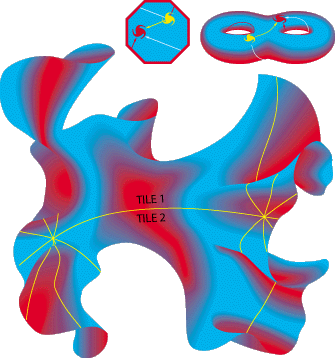
Its important to remember that the above images are 2D shadows of 4D space, it is impossible to draw the geometry of the Universe on a piece of paper (although we can come close with a hypercube), it can only be described by mathematics. All possible Universes are finite since there is only a finite age and, therefore, a limiting horizon. The geometry may be flat or open, and therefore infinite in possible size (it continues to grow forever), but the amount of mass and time in our Universe is finite.
Curvature of the Universe:
There are basically three possible shapes to the Universe; a flat Universe (Euclidean or zero curvature), a spherical Universe (positive curvature) or a hyperbolic Universe (negative curvature). Note that this curvature is similar to spacetime curvature due to stellar masses except that the entire mass of the Universe determines the curvature. So a high mass Universe has positive curvature, a low mass Universe has negative curvature.
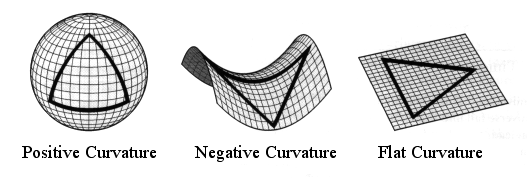
All three geometries are classes of what is called Riemannian geometry, based on three possible states for parallel lines
or one can think of triangles where for a flat Universe the angles of a triangle sum to 180 degrees, in a spherical Universe the sum must be greater than 180, in an hyperbolic Universe the sum must be less than 180.
Standard cosmological observations do not say anything about how those volumes fit together to give the universe its overall shape--its topology. The three plausible cosmic geometries are consistent with many different topologies. For example, relativity would describe both a torus (a doughnutlike shape) and a plane with the same equations, even though the torus is finite and the plane is infinite. Determining the topology requires some physical understanding beyond relativity.
Measuring the curvature of the Universe is doable because of ability to see great distances with our new technology. On the Earth, it is difficult to see that we live on a sphere. One stands on a tall mountain, but the world still looks flat. One can see a ship come over the horizon, but that was thought to be atmospheric refraction for a long time.
Our current technology allows us to see over 80% of the size of the Universe, sufficient to measure curvature. Any method to measure distance and curvature requires a standard `yardstick', some physical characteristic that is identifiable at great distances and does not change with lookback time.
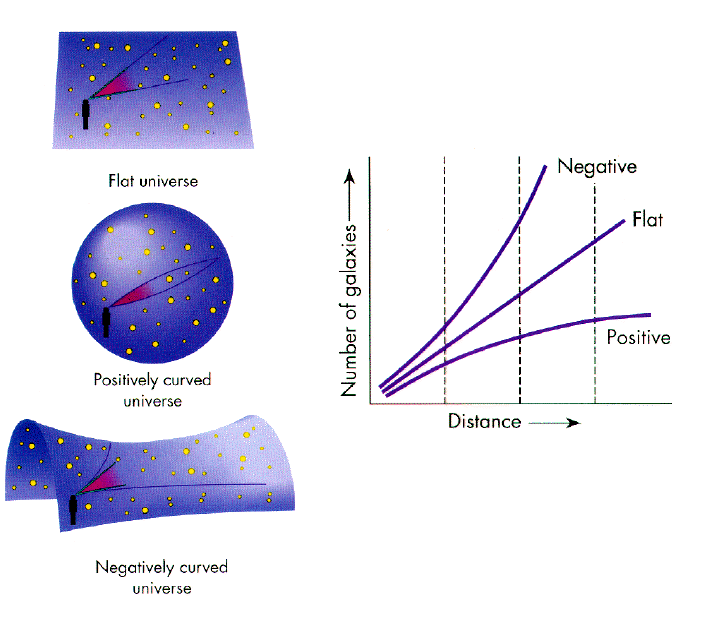
The three primary methods to measure curvature are luminosity, scale length and number. Luminosity requires an observer to find some standard `candle', such as the brightest quasars, and follow them out to high redshifts. Scale length requires that some standard size be used, such as the size of the largest galaxies. Lastly, number counts are used where one counts the number of galaxies in a box as a function of distance.
To date all these methods have been inconclusive because the brightest, size and number of galaxies changes with time in a ways that we have not figured out. So far, the measurements are consistent with a flat Universe, which is popular for aesthetic reasons.
Density of the Universe:
There are two possible futures for our Universe, continual expansion (open and flat), turn-around and collapse (closed). Note that flat is the specific case of expansion to zero velocity.
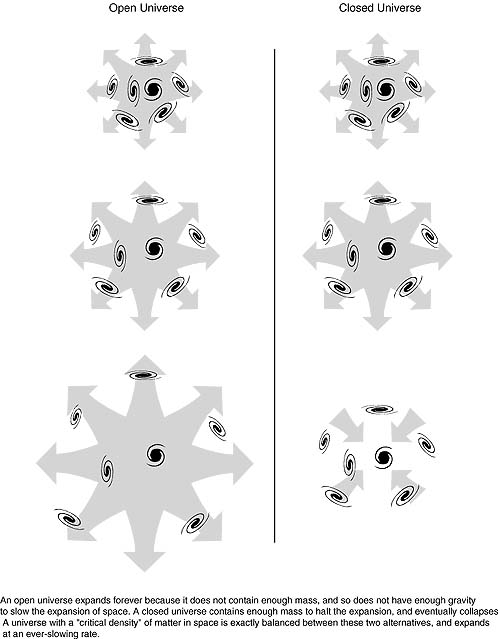
The key factor that determines which history is correct is the amount of mass/gravity for the Universe as a whole. If there is sufficient mass, then the expansion of the Universe will be slowed to the point of stopping, then retraction to collapse. If there is not a sufficient amount of mass, then the Universe will expand forever without stopping. The flat Universe is one where there is exactly the balance of mass to slow the expansion to zero, but not for collapse.
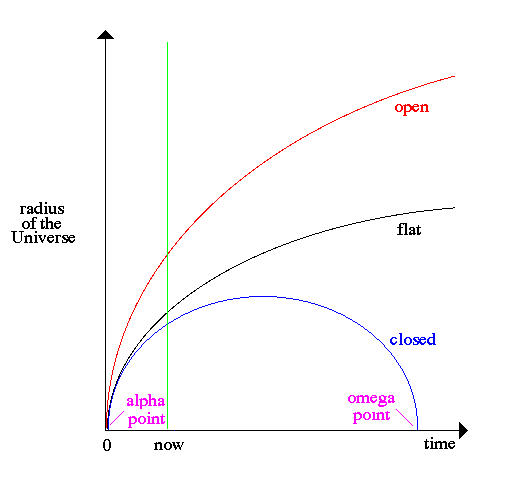
The parameter that is used to measure the mass of the Universe
is the critical density, ![]() . The cosmic density parameter,
. The cosmic density parameter,
![]() is usually expressed as the ratio of the mean density
observed to that of the density in a flat Universe.
is usually expressed as the ratio of the mean density
observed to that of the density in a flat Universe.
|
if |
|
if |
|
if |
Given all the range of values for the mean density of the
Universe, it is strangely close to the density of a flat
Universe. And our theories of the early Universe (see inflation)
strongly suggest the value of ![]() should be exactly equal to
one. If so our measurements of the density by galaxy counts or
dynamics are grossly in error and remains one of the key
problems for modern astrophysics.
should be exactly equal to
one. If so our measurements of the density by galaxy counts or
dynamics are grossly in error and remains one of the key
problems for modern astrophysics.
Cosmological Constants:
In modern cosmology, the three classes of universes (open, flat or closed) are known as Friedmann universes and described by a simple equation:

In this equation, `a' represents the scale factor of the Universe (think of it as the radius of the Universe in 4D spacetime), ρ represents the mean density of the Universe and k is the curvature (-1 for open, 0 for flat, +1 for closed). The dot over the `a' in the left-hand side of the equation means `velocity' or rate of change of the scale size of the Universe. This is measured by Hubble's constant, H, so the equation becomes:

Everything in this equation is a constant except ρ and k. So for the simple Friedmann universes you only need to measure density and Hubble's constant to determine the future of the Universe (i.e., k).
The measurement of Hubble's constant, H, and the density of the Universe,
given by ![]() has consumed major amounts of telescope
time over all wavelengths for the past 20 years. Hubble's constant has
converged on a value of about 75 due to HST observations, however, this value
only gives the expansion rate of the Universe today.
has consumed major amounts of telescope
time over all wavelengths for the past 20 years. Hubble's constant has
converged on a value of about 75 due to HST observations, however, this value
only gives the expansion rate of the Universe today.
The search for the value of ![]() is a much more
difficult undertaking. The luminous mass of the Universe is tied up in stars.
Stars are what we see when we look at a galaxy and it fairly easy to estimate
the amount of mass tied up in stars, gas, planets and assorted rocks. This
is contains an estimate of what is called the baryonic mass of the Universe,
i.e. all the stuff made of baryons = protons and neutrons. When these numbers
are calculated it is found that
is a much more
difficult undertaking. The luminous mass of the Universe is tied up in stars.
Stars are what we see when we look at a galaxy and it fairly easy to estimate
the amount of mass tied up in stars, gas, planets and assorted rocks. This
is contains an estimate of what is called the baryonic mass of the Universe,
i.e. all the stuff made of baryons = protons and neutrons. When these numbers
are calculated it is found that ![]() for baryons is
only 0.02, a very open Universe. However, when we examine motion of objects
in the Universe, we quickly realize that most of the mass of the Universe is
not seen, i.e. dark matter, which makes this estimate of
for baryons is
only 0.02, a very open Universe. However, when we examine motion of objects
in the Universe, we quickly realize that most of the mass of the Universe is
not seen, i.e. dark matter, which makes this estimate of ![]() to be much too low.
to be much too low.

|
|

|